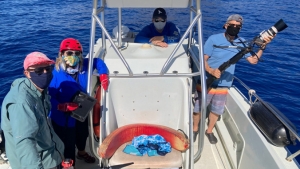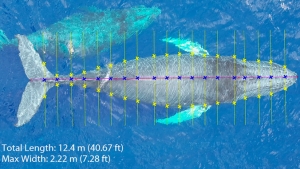Humpback whales are back in waters off of Maui after their fall migration from along the Northern Pacific rim, and the Marine Mammal Laboratory at the University of Hawaiʻi at Hilo, is continuing collaborative research on humpback whale health with scientists from Hawaiʻi and Alaska. During summers, the research team examines the same individual whales in feeding grounds off Southeast Alaska.
The laboratory was founded by Adam Pack, who holds a joint appointment in the departments of psychology and biology. On the team are Lars Bejder and Martin van Aswegen of the Marine Mammal Research Program at UH Mānoa, Jens Currie and Stephanie Stack of the Pacific Whale Foundation, Andy Szabo of Alaska Whale Foundation, Shannon Atkinson of University of Alaska, Fairbanks and Kristi West of Hawaiʻi Pacific University.

“Our goal is to learn about the physical and reproductive health of the Hawaiʻi distinct population segment of North Pacific humpback whales by measuring how whale body condition, fertility levels and indicators of stress change while calves are nursing and other whales are fasting over the course of a breeding season,” Pack said.
The team also examines how these same parameters compare with those from the same whales in the feeding grounds off Southeast Alaska. Through the long-term continuous monitoring of the whales, threats or stressors to the population are identified to provide science-based recommendations on mitigation strategies and contribute to adaptive management.
The Pacific Whale Foundation said recent observations in Hawaiʻi and Southeast Alaska have revealed declines in sighting rates of humpback whales, with a 50-75% decrease reported between 2013 and 2018. Despite the widespread popularity of humpback whales, the species continues to face several threats relating to human activities and ecosystem health, which is magnified by their preferred use of coastal habitats.
Continuous long-term monitoring is an effective research method to determine potential population changes and better predict and monitor the impacts of various stressors. Currently, in the leeward waters off Maui, the team is collecting a variety of data to gain a broad understanding of both individuals and the population at large using photo identification, tissue samples and body condition metrics captured through drone imagery.
The research

After the team sights a whale pod and determines its composition, van Aswegen, along with Pacific Whale Foundation researchers, launches a drone that hovers over each whale when it surfaces to measure its body condition.
“Simultaneously, we give the whales temporary names based on the unique shapes of their dorsal fins, allowing us to link all streams of data to a named whale, and we take tail fluke identification images of individual whales when they dive,” said Pack. “Once the drone returns and we can recognize the individual whales by sight, I carefully extract a tiny piece of blubber and skin from each whale using an arrow with a sterile stainless-steel tip projected from a crossbow.”
Thus far, the researchers have gathered more than 250 tail fluke images, measured more than 270 individual whales, and collected more than 65 biopsy samples.
In March, Pack will be back in Maui waters with the team for the second half of the humpback whale breeding season to identify, measure and obtain new samples from individuals sighted earlier in the season who have been fasting or nursing during the interim.
All research is conducted under Federal Research Permits 19655, 21321 and 21476, as well as Part 107 authorization from the Federal Aviation Administration.
—By Susan Enright, a public information specialist for the Office of the Chancellor and editor of UH Hilo Stories.
More UH News story on humpback whale research:
- Rare video captures humpback whale nursing behaviors in UH Mānoa research [VIDEO], April 19, 2020
- Whale bubble-net feeding documented by UH researchers through groundbreaking video [VIDEO], October 13, 2019
- PBS series highlights UH Hilo humpback whale research, June 24, 2019
- Rare video of newborn humpback whale from UH marine mammal research [VIDEO], January 31, 2019

